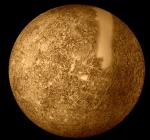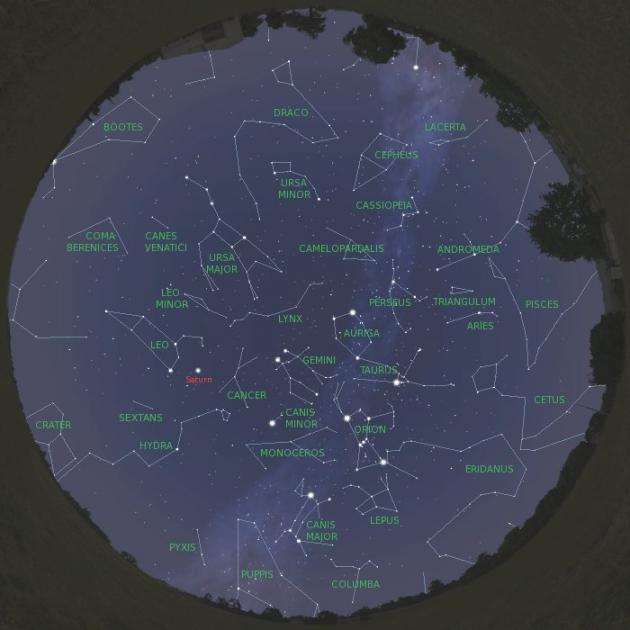- News / Thoughts
- Astronomy Guide
- On This Day
- Reviews
- Bookstore
Astronomical Events for February 2007
01/27/2007

Planet Mercury.
Image credit: NASA, USGS
Main actor this month will be planet Mercury. Looking from Earth, he has moved far enough from our star to be safely seen in the first half of February.
The other two planets visible this month are Venus and Saturn. We saw them last month too, but now they are even better positioned for viewing.
O

Evening sky for the middle of February 2007. at 9PM. The map is valid for northern hemisphere, especially positions near 45 degrees latitude.
Mercury, being smallest and the closest planet to the Sun, has proved to be quite a puzzle. It is always really near the Sun, around which it goes in obviously elliptic orbit. The glow of our star doesn't allow us to see any details on Mercury, and only did NASA's mission Mariner 10, back in 1974., managed to partially cartograph it's surface.
Starting January 31 until February 14., Mercury will be observable with the naked eye after sunset. Don't mistake it with Venus, which is much brighter then him. If you're able, use your telescope during those 15 days. Although we don't see any details on Mercury, it'll be seen as crescent, just like Moon phases. The change of the Mercury's phases will be quite obvious from day to day, and if you're into astrophotography, you might make a small animation.
Mercury will be in company of Venus, which will be seen as the brightest "star" after sunset. We've mentioned her last month, but this month it'll be a bit higher, and therefore linger a bit more in the evening sky for our enjoyment.
This two planets need an important viewing notice: look at them only when the Sun goes bellow horizon. Looking at the Sun, especially using devices like binoculars or telescopes, will blind you until the end of your life. So bear this warning forever. Mercury and Venus will still be in the sky after the Sun sets, and then you can safely gaze at them.
Concerning planets, we have one more: Saturn. The ring bearer is in the constellation of Leo. He is rising early in the evening in the east. Therefore his rings will continue to adorn the sky throughout February.
Last month we've described winter hexagon which is used to ease orientation on the winter sky. For practice you might want to find other winter constellations from the evening sky representation at the top of the page.
We'll end with moon phases for February 2007.
- Full Moon - February 2. 05:45 UT
- Last Quarter - February 10. 09:51 UT
- New Moon - February 17. 16:14 UT
- First Quarter - February 24. 07:56 UT